Clifton Peak is a prominent landform as seen entering the town of Clifton, Arizona (Fig. 1). Geologically it a series of silicic volcanic flows and ashes. The center of the peak has been brecciated with agate cementing the breccia fragments. The agate in this breccia has thus far not yielded anything of interest. Along the flanks of Clifton peak are a series of cliffs containing veins and pods of agate, these veins are likely derived from the main breccia. Most of the veins are unattractive, similar to the agate in the breccia.
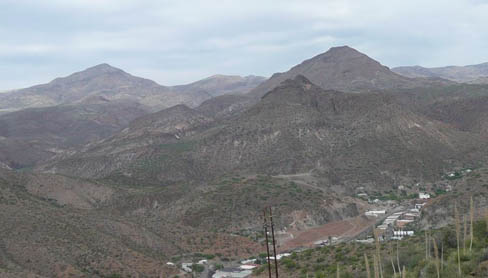
View of Clifton and surrounding mountains from Morenci, Arizona, taken from about 2 miles away.
The smaller mountain in the foreground is Clifton Peak.
Clifton Peak is well known to agate collectors and has been discussed in various forms in multiple guide books, as a result I have visited the mountain, searching for agate numerous times. In December 2007, January 2008 and February 2008 I encountered a number of pockets in the cliffs and crags of Clifton Peak that yielded numerous noteworthy specimens of agate stalactites, most commonly coated with a highly vitreous quartz druze (Fig. 2).
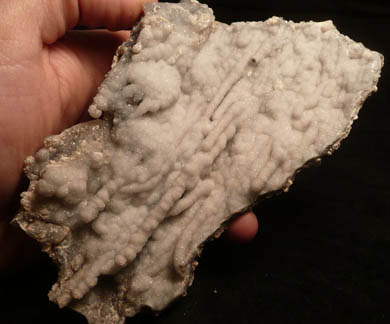
Specimen collected from corner of vug opened on Feb. 3rd (see below).
Specimen about 12 cm long.
In late December 2007 I decided to take a hike to the top of Clifton peak and have a look around the upper portions of the mountain for agate. I was really hoping to find fire agate but instead I found a fantastic piece of float below the cliffs, composed of stalactitic agate with a druzy quartz coating (Fig. 3).
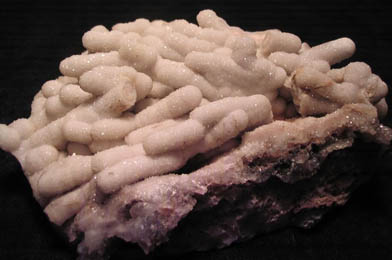
White sub-parallel stalactites. Few broken ends show banding with pink bands.
Specimen is about 12 cm across.
Following more float up the mountain I discovered an area where stalactites were weathering out of in situ pockets. I collected one nice softball sized vug and numerous other isolated pieces (Fig. 4). Leaving I knew I would be back soon.
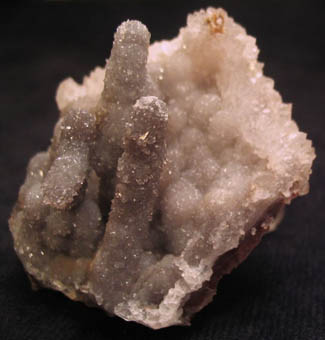
Agate stalactites collected form first in situ vug.
Specimen is about 5 cm high.
On Jan 5th, 2008 I headed up with a friend to make the same traverse I made in December, hoping to locate more perspective areas along the cliffs now that I knew what potential existed. We got a late start and an hour or two before the setting sun was forcing us to start our decent home I located a vug by following float. This area was about 1500 feet or so from the area identified in December. I removed one nice specimen with two stalactites from a pocket, which looked to have great potential (Fig. 5). The stalactites were different in this area, as compared to the December pockets, in that the stalactites were quite bumpy and the druzy quartz coating was finer-grained. Also, they were slightly bluish where as the first finds were white to gray.
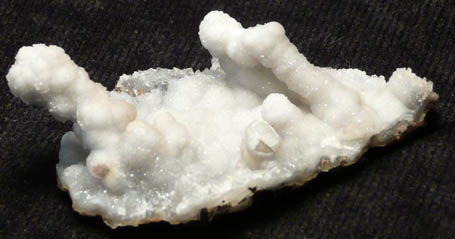
Specimen is about 5 cm across.
I returned to this vug on Feb 3rd, 2008, this time with a few pounds more steel and a bit more time. I removed the rock in front of the previously described pocket found on the 5th of January. Plates covered with stalactites started “falling” out from behind these rocks! Dozens of plates and pieces (Fig. 6 and Fig. 7).
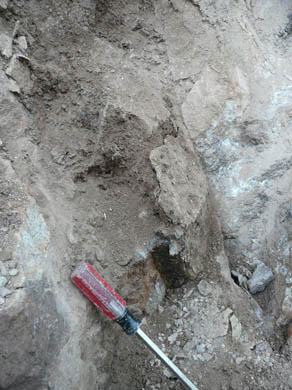
Vug discovered Jan 5th, 2008.
Average sized screwdriver for scale.
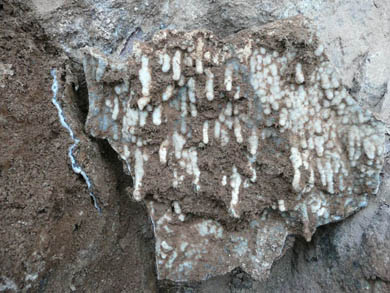
Stalactite plate, just collected from vug in Fig. 7, which shows the specimen of Fig. 8 in situ.
About 20 cm across.
After opening the pocket completely it measured about 100 cm by 45 cm and many specimens were recovered. The bottom of the vug contained dozens of loose stalactites that had broken off long before I ever arrived (Fig. 8). Some even had broken ends overgrown by druzy quartz.
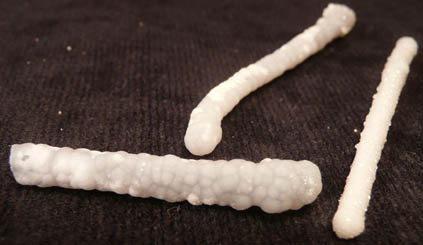
Stalactites are about 5 cm long.
It was about a month before I made time to revisit that peak in Clifton. This time I returned to the area identified in December. There were two mineralization styles observable:
1) Discrete veins and pods that had very thin walls (less than 1 mm thick) with late stage quartz “flowers” upon the agate.
2) Pods of thick walled banded agate with druzy quartz coatings.
The second style of mineralization described produced the most desirable specimens. Both types produced stalactites, the thin walled veins contained lots of stalactites that were commonly found in jumbled piles at the bottoms of pockets and very thin and fragile (Fig. 9), but the thick walled banded agate produced more robust stalactites and the sparkle of druzy overgrowth really sets them off (Fig. 10). Two pockets found in this area each yielded a significant single specimen upon two trips 5 days apart (Fig. 10 and Fig 11).
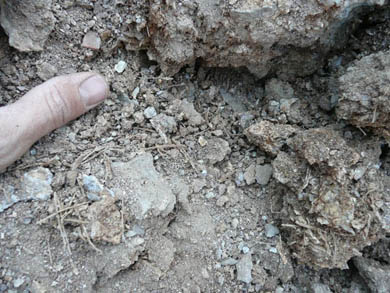
Thin walled agate vug showing jumbled collection of thin stalactites.
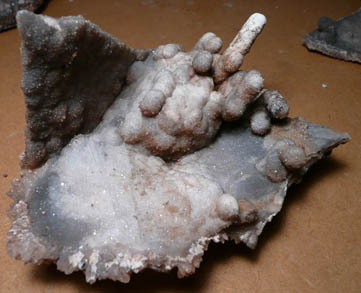
Specimen collected from thick walled agate vug. Specimen about 12 cm across.
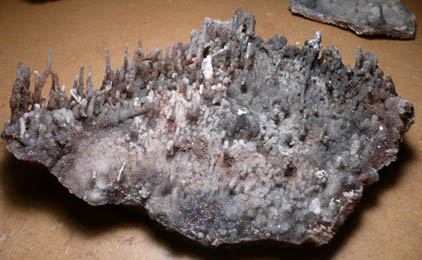
Collected from a unique vug from the thin walled agate style.
It is unique in that the thin stalactites have a druzy quartz overgrowth,
not typically observed with the thin stalactite vugs.
Specimen about 20 cm across.
Despite numerous trips and many tons of material moved (Fig. 12), only a very few more notable pockets were encountered, and they were all quite small. One pocket yielded small stalactites forming arches (Fig. 13) and another yield two small lavender stalactites. No matter what collecting success, the views are always priceless (Fig. 14)!
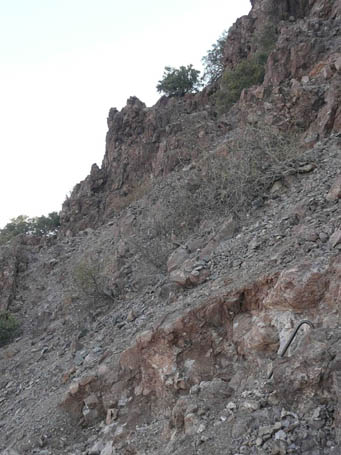
Hole author made searching for agate stalactite vugs on Clifton Peak.
Bar is about 60 cm long. Photo taken is April of 2008.
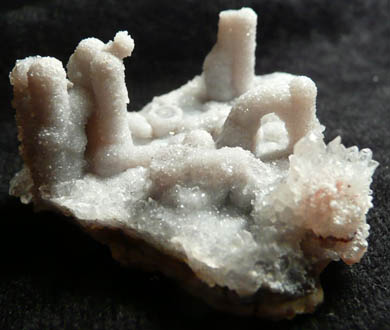
Specimen is about 4 cm across.
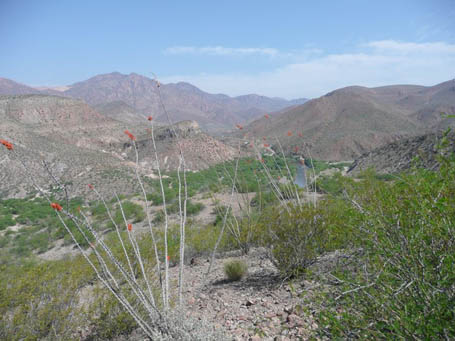
Looking north from Clifton Peak. This is the San Francisco river valley.